Exploring Closing the Gap Policy and Social Determinants of Health
VerifiedAdded on 2022/09/05
|8
|2103
|24
Essay
AI Summary
This paper provides an in-depth analysis of Australia's Closing the Gap policy, which aims to improve the health and well-being of Aboriginal and Torres Strait Islander populations. It begins by outlining the policy's goals, targets, and historical context, emphasizing its commitment to health equality. The paper then explores the social determinants of health (SDH), such as financial stability, social circumstances, and access to healthcare, and how these factors influence the health outcomes of Indigenous Australians. A case study of a 57-year-old widowed woman, Judy, with a leg ulcer and type 2 diabetes, is used to illustrate the impact of SDH. The paper discusses the roles of Aboriginal Medical Services (AMS) and Aboriginal Liaison Officers (ABO) in supporting patients like Judy, and explains how individuals can register with the Closing the Gap policy to access healthcare benefits. Finally, the paper highlights the challenges and progress related to achieving the policy's targets, concluding that the Closing the Gap policy is crucial in improving the living conditions and health outcomes of Indigenous Australians.
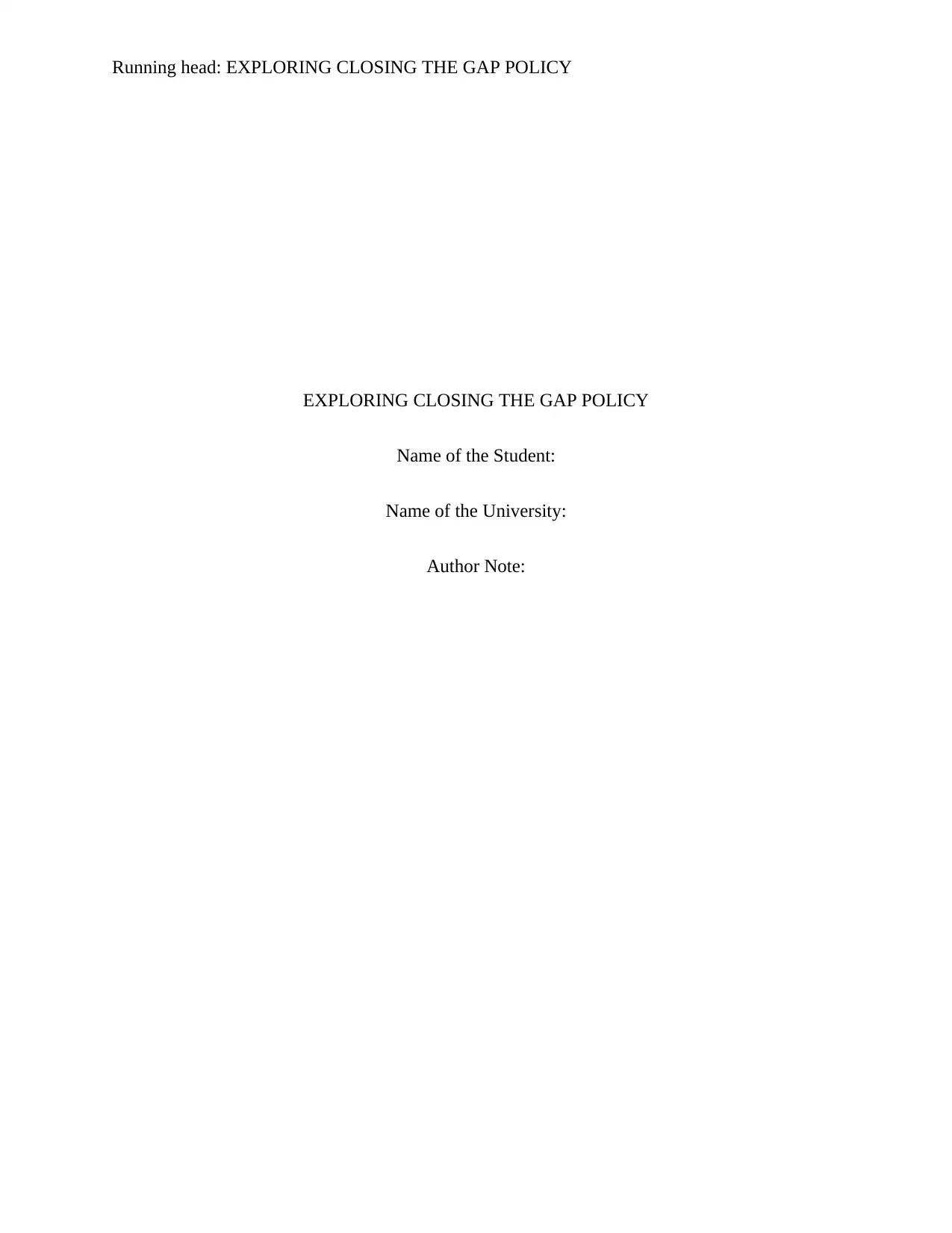
Running head: EXPLORING CLOSING THE GAP POLICY
EXPLORING CLOSING THE GAP POLICY
Name of the Student:
Name of the University:
Author Note:
EXPLORING CLOSING THE GAP POLICY
Name of the Student:
Name of the University:
Author Note:
Paraphrase This Document
Need a fresh take? Get an instant paraphrase of this document with our AI Paraphraser
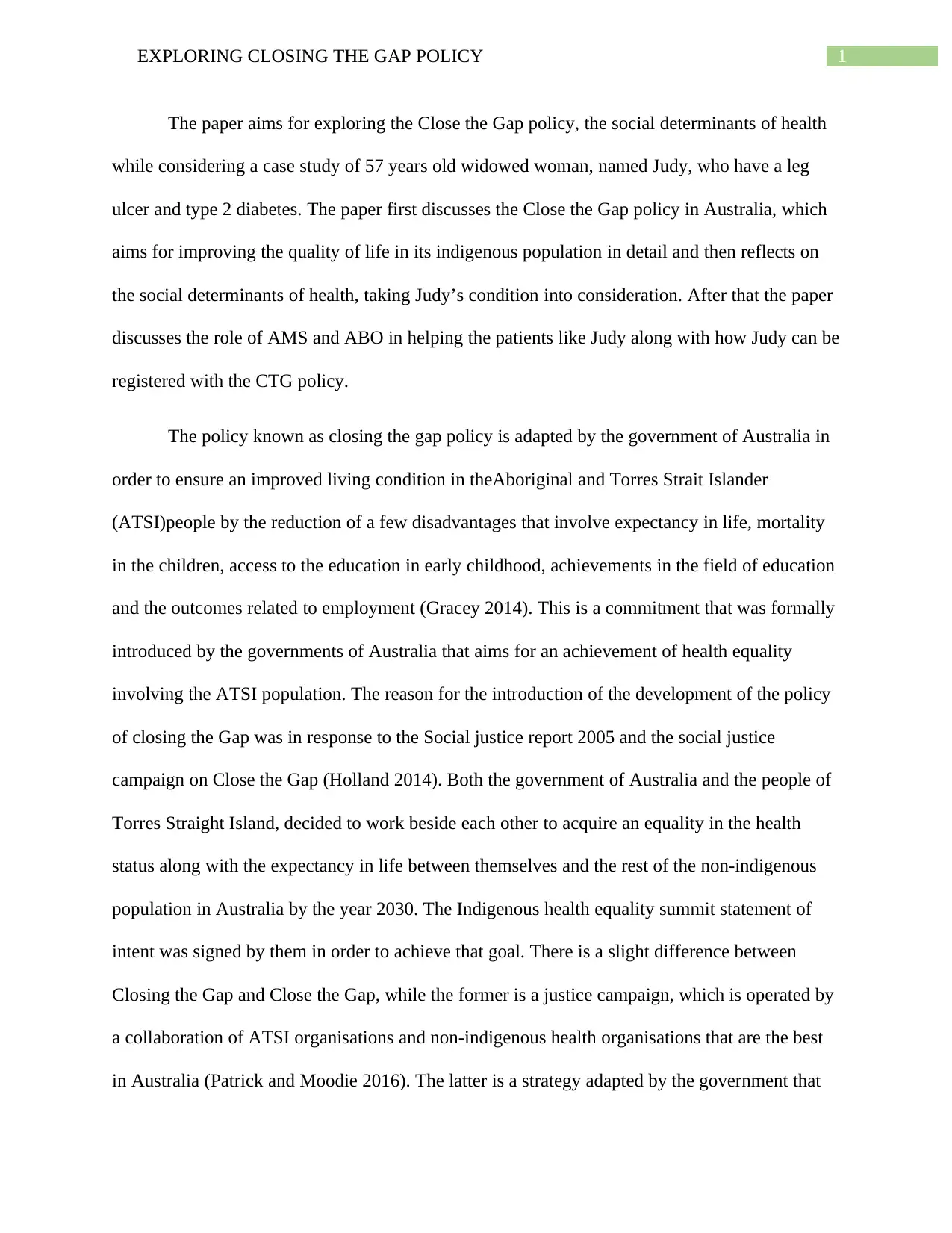
1EXPLORING CLOSING THE GAP POLICY
The paper aims for exploring the Close the Gap policy, the social determinants of health
while considering a case study of 57 years old widowed woman, named Judy, who have a leg
ulcer and type 2 diabetes. The paper first discusses the Close the Gap policy in Australia, which
aims for improving the quality of life in its indigenous population in detail and then reflects on
the social determinants of health, taking Judy’s condition into consideration. After that the paper
discusses the role of AMS and ABO in helping the patients like Judy along with how Judy can be
registered with the CTG policy.
The policy known as closing the gap policy is adapted by the government of Australia in
order to ensure an improved living condition in theAboriginal and Torres Strait Islander
(ATSI)people by the reduction of a few disadvantages that involve expectancy in life, mortality
in the children, access to the education in early childhood, achievements in the field of education
and the outcomes related to employment (Gracey 2014). This is a commitment that was formally
introduced by the governments of Australia that aims for an achievement of health equality
involving the ATSI population. The reason for the introduction of the development of the policy
of closing the Gap was in response to the Social justice report 2005 and the social justice
campaign on Close the Gap (Holland 2014). Both the government of Australia and the people of
Torres Straight Island, decided to work beside each other to acquire an equality in the health
status along with the expectancy in life between themselves and the rest of the non-indigenous
population in Australia by the year 2030. The Indigenous health equality summit statement of
intent was signed by them in order to achieve that goal. There is a slight difference between
Closing the Gap and Close the Gap, while the former is a justice campaign, which is operated by
a collaboration of ATSI organisations and non-indigenous health organisations that are the best
in Australia (Patrick and Moodie 2016). The latter is a strategy adapted by the government that
The paper aims for exploring the Close the Gap policy, the social determinants of health
while considering a case study of 57 years old widowed woman, named Judy, who have a leg
ulcer and type 2 diabetes. The paper first discusses the Close the Gap policy in Australia, which
aims for improving the quality of life in its indigenous population in detail and then reflects on
the social determinants of health, taking Judy’s condition into consideration. After that the paper
discusses the role of AMS and ABO in helping the patients like Judy along with how Judy can be
registered with the CTG policy.
The policy known as closing the gap policy is adapted by the government of Australia in
order to ensure an improved living condition in theAboriginal and Torres Strait Islander
(ATSI)people by the reduction of a few disadvantages that involve expectancy in life, mortality
in the children, access to the education in early childhood, achievements in the field of education
and the outcomes related to employment (Gracey 2014). This is a commitment that was formally
introduced by the governments of Australia that aims for an achievement of health equality
involving the ATSI population. The reason for the introduction of the development of the policy
of closing the Gap was in response to the Social justice report 2005 and the social justice
campaign on Close the Gap (Holland 2014). Both the government of Australia and the people of
Torres Straight Island, decided to work beside each other to acquire an equality in the health
status along with the expectancy in life between themselves and the rest of the non-indigenous
population in Australia by the year 2030. The Indigenous health equality summit statement of
intent was signed by them in order to achieve that goal. There is a slight difference between
Closing the Gap and Close the Gap, while the former is a justice campaign, which is operated by
a collaboration of ATSI organisations and non-indigenous health organisations that are the best
in Australia (Patrick and Moodie 2016). The latter is a strategy adapted by the government that

2EXPLORING CLOSING THE GAP POLICY
aims for improving the living conditions of the indigenous population of Australia.The council of
Australian Government has set targets that can be subjected to the measurement in order to
monitor the physical and mental well-being and the improved health conditions in the people
from ATSI population, which include, reduce the gap in the rate of child death into half by the
year 2018, reduce the gap into half in case of employment, literacy and school attendance by the
year 2018, reduce the gap in attainment of 12th year for the students by the year 2020, make sure
that almost all the children of four year old age from the ATSI population becomes enrolled for
an early start in education by the year 2025,close the gap in case of the expectancy in life by the
year 2031(Saunders 2015).The Australian government monitor the progress of this closing the
gap strategy continuously. The challenges regarding this close the gap targets facing both the
Australian government and the whole nation, can be recognised by the set timeframes, since the
improvements involving various targets cannot occur within a short time frame.
The social determinants of health (SDH) can be described as the factors in relation to
personal, social, economic and environmental conditions of an individual influencing their
physical or mental health. There are mainly five key determinants of SDH, which includes
proper education, financial stability, social circumstances, proper environmental and
neighbourhood conditions and finally proper healthcare (Marmot and Allen 2014). Three SDH
can be identified while considering the case study report provided, which involve a 57 year old
aboriginal patient, named Judy.
The first determinant can be taken into account is the financial stability of an individual.
The financial stability is dependent widely on the employment and also on the housing and the
living arrangements. The financial stability can be linked with an individual’s health by the
access of an individual to the expensive treatment procedures, the expense of transport to reach a
aims for improving the living conditions of the indigenous population of Australia.The council of
Australian Government has set targets that can be subjected to the measurement in order to
monitor the physical and mental well-being and the improved health conditions in the people
from ATSI population, which include, reduce the gap in the rate of child death into half by the
year 2018, reduce the gap into half in case of employment, literacy and school attendance by the
year 2018, reduce the gap in attainment of 12th year for the students by the year 2020, make sure
that almost all the children of four year old age from the ATSI population becomes enrolled for
an early start in education by the year 2025,close the gap in case of the expectancy in life by the
year 2031(Saunders 2015).The Australian government monitor the progress of this closing the
gap strategy continuously. The challenges regarding this close the gap targets facing both the
Australian government and the whole nation, can be recognised by the set timeframes, since the
improvements involving various targets cannot occur within a short time frame.
The social determinants of health (SDH) can be described as the factors in relation to
personal, social, economic and environmental conditions of an individual influencing their
physical or mental health. There are mainly five key determinants of SDH, which includes
proper education, financial stability, social circumstances, proper environmental and
neighbourhood conditions and finally proper healthcare (Marmot and Allen 2014). Three SDH
can be identified while considering the case study report provided, which involve a 57 year old
aboriginal patient, named Judy.
The first determinant can be taken into account is the financial stability of an individual.
The financial stability is dependent widely on the employment and also on the housing and the
living arrangements. The financial stability can be linked with an individual’s health by the
access of an individual to the expensive treatment procedures, the expense of transport to reach a
⊘ This is a preview!⊘
Do you want full access?
Subscribe today to unlock all pages.

Trusted by 1+ million students worldwide
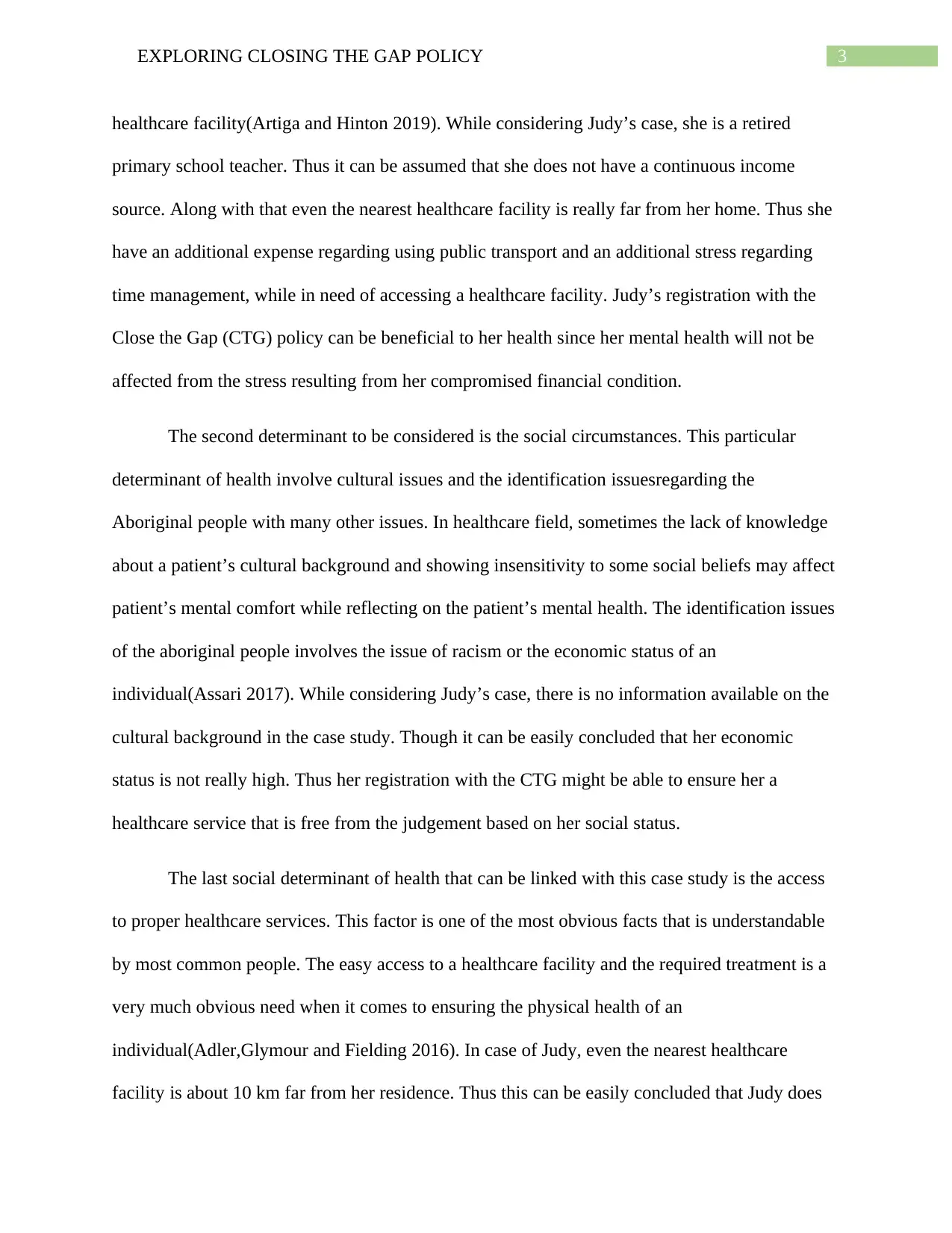
3EXPLORING CLOSING THE GAP POLICY
healthcare facility(Artiga and Hinton 2019). While considering Judy’s case, she is a retired
primary school teacher. Thus it can be assumed that she does not have a continuous income
source. Along with that even the nearest healthcare facility is really far from her home. Thus she
have an additional expense regarding using public transport and an additional stress regarding
time management, while in need of accessing a healthcare facility. Judy’s registration with the
Close the Gap (CTG) policy can be beneficial to her health since her mental health will not be
affected from the stress resulting from her compromised financial condition.
The second determinant to be considered is the social circumstances. This particular
determinant of health involve cultural issues and the identification issuesregarding the
Aboriginal people with many other issues. In healthcare field, sometimes the lack of knowledge
about a patient’s cultural background and showing insensitivity to some social beliefs may affect
patient’s mental comfort while reflecting on the patient’s mental health. The identification issues
of the aboriginal people involves the issue of racism or the economic status of an
individual(Assari 2017). While considering Judy’s case, there is no information available on the
cultural background in the case study. Though it can be easily concluded that her economic
status is not really high. Thus her registration with the CTG might be able to ensure her a
healthcare service that is free from the judgement based on her social status.
The last social determinant of health that can be linked with this case study is the access
to proper healthcare services. This factor is one of the most obvious facts that is understandable
by most common people. The easy access to a healthcare facility and the required treatment is a
very much obvious need when it comes to ensuring the physical health of an
individual(Adler,Glymour and Fielding 2016). In case of Judy, even the nearest healthcare
facility is about 10 km far from her residence. Thus this can be easily concluded that Judy does
healthcare facility(Artiga and Hinton 2019). While considering Judy’s case, she is a retired
primary school teacher. Thus it can be assumed that she does not have a continuous income
source. Along with that even the nearest healthcare facility is really far from her home. Thus she
have an additional expense regarding using public transport and an additional stress regarding
time management, while in need of accessing a healthcare facility. Judy’s registration with the
Close the Gap (CTG) policy can be beneficial to her health since her mental health will not be
affected from the stress resulting from her compromised financial condition.
The second determinant to be considered is the social circumstances. This particular
determinant of health involve cultural issues and the identification issuesregarding the
Aboriginal people with many other issues. In healthcare field, sometimes the lack of knowledge
about a patient’s cultural background and showing insensitivity to some social beliefs may affect
patient’s mental comfort while reflecting on the patient’s mental health. The identification issues
of the aboriginal people involves the issue of racism or the economic status of an
individual(Assari 2017). While considering Judy’s case, there is no information available on the
cultural background in the case study. Though it can be easily concluded that her economic
status is not really high. Thus her registration with the CTG might be able to ensure her a
healthcare service that is free from the judgement based on her social status.
The last social determinant of health that can be linked with this case study is the access
to proper healthcare services. This factor is one of the most obvious facts that is understandable
by most common people. The easy access to a healthcare facility and the required treatment is a
very much obvious need when it comes to ensuring the physical health of an
individual(Adler,Glymour and Fielding 2016). In case of Judy, even the nearest healthcare
facility is about 10 km far from her residence. Thus this can be easily concluded that Judy does
Paraphrase This Document
Need a fresh take? Get an instant paraphrase of this document with our AI Paraphraser

4EXPLORING CLOSING THE GAP POLICY
not have an easy access to the healthcare service. Her registration with CTG may help her in
changing this condition.
The patients who belong from the ATSI population, are eligible for the registration with
CTG, if they have a risk of developing a chronic disease or already living with one and cannot
afford the expenses regarding treatment. The patients can register at Indigenous Health Services
or in the Practice Incentives Program. The registered patients are eligible for the access to the
Pharmaceutical Benefits Scheme (PBS), which gives them the access to the free medicines or the
low cost medicines(Humanservices.gov.au, 2019). Since Judy have a leg ulcer along with the
type 2 diabetes and is also unable to afford the cost of her treatment, she can be considered
eligible for the registration with CTG and she can register as per the procedure mentioned above.
The Aboriginal Medical Services (AMS) are focused on providing medical services that
are culturally more appropriate than that of the mainstream services. The AMS address the
negative impacts resulting from the social discriminations. The professionals working in this
field, assess the patient’s health conditions along with their socio-economic background and
decides the most appropriate and accessible medical services for them(Baba, Brolan and Hill
2014). The Aboriginal Liaison Officers (ABO) are the healthcare professionals, who help the
patient while communicating with the medical and healthcare professionals and understanding
the procedures and goals set for their medical treatments (McKenna et al. 2015). Both the AMS
and the ABO assigned to Judy can help her with her socio-economic status while accessing a
healthcare service. They can help them communicating with the healthcare professionals and
also in making her understand the proper course of action regarding her health condition. The
AMS suggested a daily dressings for her ulcerated legs that should be done by the community
nurses. The possible reason for this consideration of AMS might be based on the fact that Judy is
not have an easy access to the healthcare service. Her registration with CTG may help her in
changing this condition.
The patients who belong from the ATSI population, are eligible for the registration with
CTG, if they have a risk of developing a chronic disease or already living with one and cannot
afford the expenses regarding treatment. The patients can register at Indigenous Health Services
or in the Practice Incentives Program. The registered patients are eligible for the access to the
Pharmaceutical Benefits Scheme (PBS), which gives them the access to the free medicines or the
low cost medicines(Humanservices.gov.au, 2019). Since Judy have a leg ulcer along with the
type 2 diabetes and is also unable to afford the cost of her treatment, she can be considered
eligible for the registration with CTG and she can register as per the procedure mentioned above.
The Aboriginal Medical Services (AMS) are focused on providing medical services that
are culturally more appropriate than that of the mainstream services. The AMS address the
negative impacts resulting from the social discriminations. The professionals working in this
field, assess the patient’s health conditions along with their socio-economic background and
decides the most appropriate and accessible medical services for them(Baba, Brolan and Hill
2014). The Aboriginal Liaison Officers (ABO) are the healthcare professionals, who help the
patient while communicating with the medical and healthcare professionals and understanding
the procedures and goals set for their medical treatments (McKenna et al. 2015). Both the AMS
and the ABO assigned to Judy can help her with her socio-economic status while accessing a
healthcare service. They can help them communicating with the healthcare professionals and
also in making her understand the proper course of action regarding her health condition. The
AMS suggested a daily dressings for her ulcerated legs that should be done by the community
nurses. The possible reason for this consideration of AMS might be based on the fact that Judy is

5EXPLORING CLOSING THE GAP POLICY
not in need of a special attention and sensitivity in regards to her cultural background and her
economic condition as well as the physical condition were fragile enough to access the services
provided by the healthcare centre that is situated about 10 km far away from her residence.
Hence it can be concluded from the above discussion is that Close the Gap policy is
focused on improving the living conditions of the ATSI People. Both the Australian government
and the whole nation are involved in setting various measurable targets to achieve that goal of
acquiring equity in health between the indigenous and the ASTI population of Australia. There
are five SDH that ensure the health along with the physical and mental well-being of an
individual. In the provided case study, the lack of financial stability, socio-economic status
reflects the possibility of affecting Judy’s mental health and also the physical health and the lack
of proper health care access also contribute in the possibility of affecting her physical health.
Judy is eligible for registration with CTG. The AMS and ABO considers her eligible for
accessing the mainstream medical services since she does not have any issues regarding the
sensitivity of her cultural background.
not in need of a special attention and sensitivity in regards to her cultural background and her
economic condition as well as the physical condition were fragile enough to access the services
provided by the healthcare centre that is situated about 10 km far away from her residence.
Hence it can be concluded from the above discussion is that Close the Gap policy is
focused on improving the living conditions of the ATSI People. Both the Australian government
and the whole nation are involved in setting various measurable targets to achieve that goal of
acquiring equity in health between the indigenous and the ASTI population of Australia. There
are five SDH that ensure the health along with the physical and mental well-being of an
individual. In the provided case study, the lack of financial stability, socio-economic status
reflects the possibility of affecting Judy’s mental health and also the physical health and the lack
of proper health care access also contribute in the possibility of affecting her physical health.
Judy is eligible for registration with CTG. The AMS and ABO considers her eligible for
accessing the mainstream medical services since she does not have any issues regarding the
sensitivity of her cultural background.
⊘ This is a preview!⊘
Do you want full access?
Subscribe today to unlock all pages.

Trusted by 1+ million students worldwide
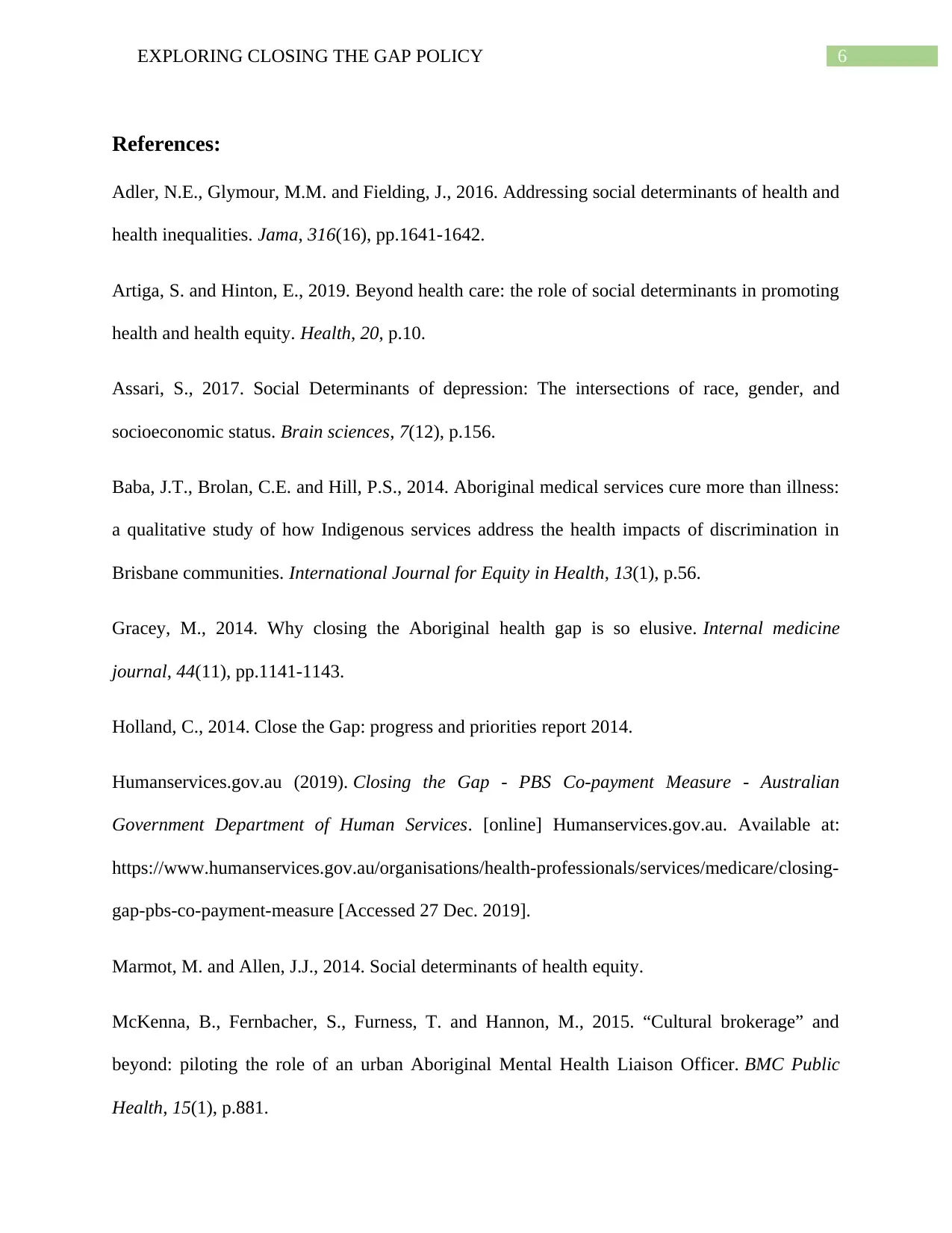
6EXPLORING CLOSING THE GAP POLICY
References:
Adler, N.E., Glymour, M.M. and Fielding, J., 2016. Addressing social determinants of health and
health inequalities. Jama, 316(16), pp.1641-1642.
Artiga, S. and Hinton, E., 2019. Beyond health care: the role of social determinants in promoting
health and health equity. Health, 20, p.10.
Assari, S., 2017. Social Determinants of depression: The intersections of race, gender, and
socioeconomic status. Brain sciences, 7(12), p.156.
Baba, J.T., Brolan, C.E. and Hill, P.S., 2014. Aboriginal medical services cure more than illness:
a qualitative study of how Indigenous services address the health impacts of discrimination in
Brisbane communities. International Journal for Equity in Health, 13(1), p.56.
Gracey, M., 2014. Why closing the Aboriginal health gap is so elusive. Internal medicine
journal, 44(11), pp.1141-1143.
Holland, C., 2014. Close the Gap: progress and priorities report 2014.
Humanservices.gov.au (2019). Closing the Gap - PBS Co-payment Measure - Australian
Government Department of Human Services. [online] Humanservices.gov.au. Available at:
https://www.humanservices.gov.au/organisations/health-professionals/services/medicare/closing-
gap-pbs-co-payment-measure [Accessed 27 Dec. 2019].
Marmot, M. and Allen, J.J., 2014. Social determinants of health equity.
McKenna, B., Fernbacher, S., Furness, T. and Hannon, M., 2015. “Cultural brokerage” and
beyond: piloting the role of an urban Aboriginal Mental Health Liaison Officer. BMC Public
Health, 15(1), p.881.
References:
Adler, N.E., Glymour, M.M. and Fielding, J., 2016. Addressing social determinants of health and
health inequalities. Jama, 316(16), pp.1641-1642.
Artiga, S. and Hinton, E., 2019. Beyond health care: the role of social determinants in promoting
health and health equity. Health, 20, p.10.
Assari, S., 2017. Social Determinants of depression: The intersections of race, gender, and
socioeconomic status. Brain sciences, 7(12), p.156.
Baba, J.T., Brolan, C.E. and Hill, P.S., 2014. Aboriginal medical services cure more than illness:
a qualitative study of how Indigenous services address the health impacts of discrimination in
Brisbane communities. International Journal for Equity in Health, 13(1), p.56.
Gracey, M., 2014. Why closing the Aboriginal health gap is so elusive. Internal medicine
journal, 44(11), pp.1141-1143.
Holland, C., 2014. Close the Gap: progress and priorities report 2014.
Humanservices.gov.au (2019). Closing the Gap - PBS Co-payment Measure - Australian
Government Department of Human Services. [online] Humanservices.gov.au. Available at:
https://www.humanservices.gov.au/organisations/health-professionals/services/medicare/closing-
gap-pbs-co-payment-measure [Accessed 27 Dec. 2019].
Marmot, M. and Allen, J.J., 2014. Social determinants of health equity.
McKenna, B., Fernbacher, S., Furness, T. and Hannon, M., 2015. “Cultural brokerage” and
beyond: piloting the role of an urban Aboriginal Mental Health Liaison Officer. BMC Public
Health, 15(1), p.881.
Paraphrase This Document
Need a fresh take? Get an instant paraphrase of this document with our AI Paraphraser
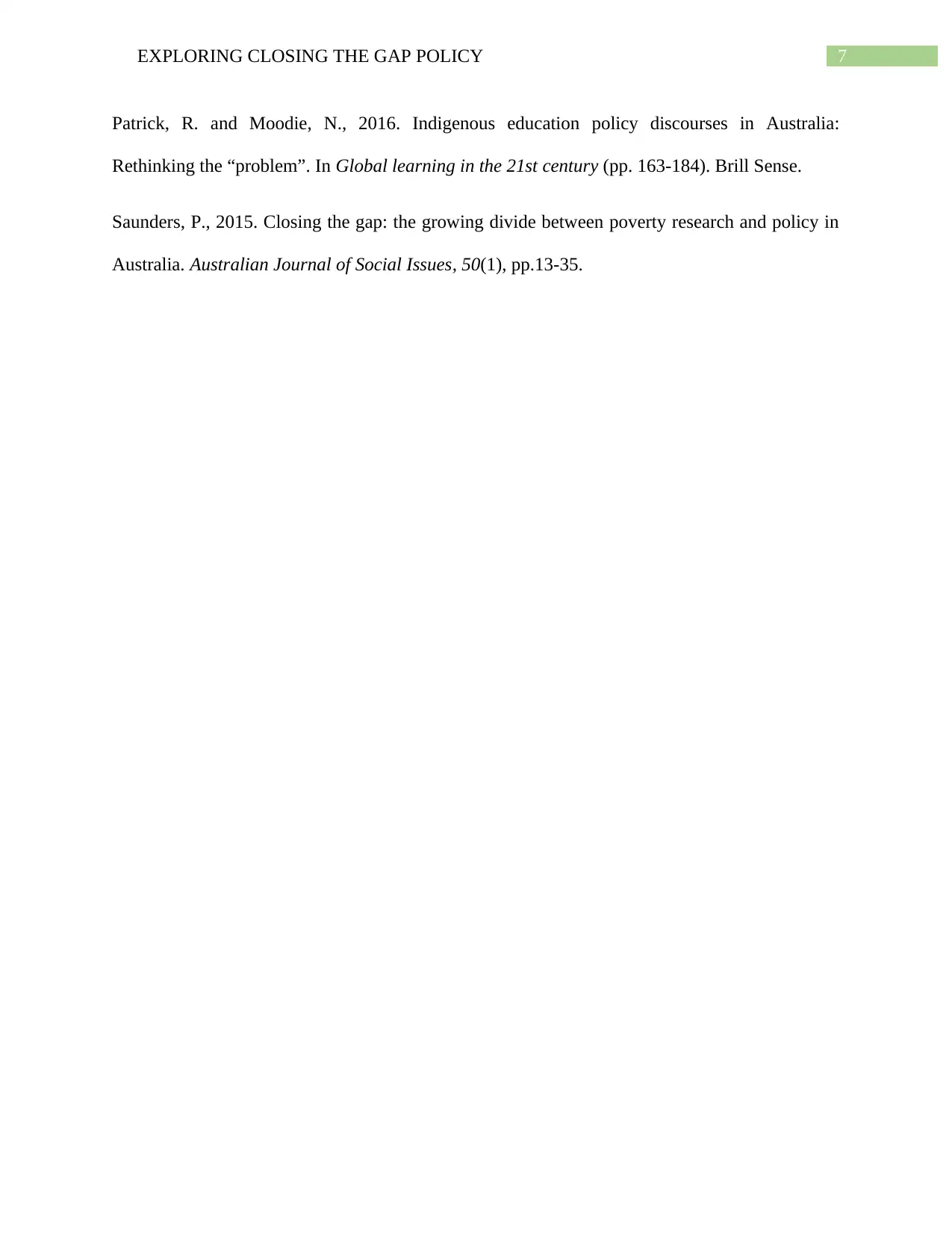
7EXPLORING CLOSING THE GAP POLICY
Patrick, R. and Moodie, N., 2016. Indigenous education policy discourses in Australia:
Rethinking the “problem”. In Global learning in the 21st century (pp. 163-184). Brill Sense.
Saunders, P., 2015. Closing the gap: the growing divide between poverty research and policy in
Australia. Australian Journal of Social Issues, 50(1), pp.13-35.
Patrick, R. and Moodie, N., 2016. Indigenous education policy discourses in Australia:
Rethinking the “problem”. In Global learning in the 21st century (pp. 163-184). Brill Sense.
Saunders, P., 2015. Closing the gap: the growing divide between poverty research and policy in
Australia. Australian Journal of Social Issues, 50(1), pp.13-35.
1 out of 8
Related Documents
Your All-in-One AI-Powered Toolkit for Academic Success.
+13062052269
info@desklib.com
Available 24*7 on WhatsApp / Email
![[object Object]](/_next/static/media/star-bottom.7253800d.svg)
Unlock your academic potential
Copyright © 2020–2025 A2Z Services. All Rights Reserved. Developed and managed by ZUCOL.





